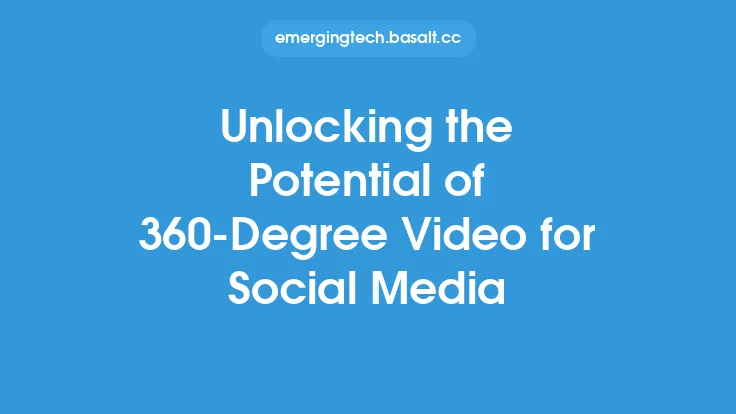The concept of 360-degree video has been around for several years, but it's only recently that we've seen significant advancements in the technology and its applications. As we move forward, it's essential to explore the trends and predictions that will shape the future of 360-degree video. In this article, we'll delve into the latest developments, innovations, and forecasts that will impact the industry and its users.
Introduction to 360-Degree Video Technology
360-degree video, also known as spherical video or immersive video, is a type of video recording that captures a 360-degree view of a scene. This is achieved using specialized cameras that have multiple lenses, which are then stitched together to create a seamless, panoramic video. The resulting video can be viewed on various devices, including smartphones, tablets, and virtual reality (VR) headsets. The technology has improved significantly over the years, with advancements in camera resolution, stitching software, and playback platforms.
Advancements in 360-Degree Video Capture
One of the most significant trends in 360-degree video is the improvement in capture technology. New cameras are being developed with higher resolutions, wider fields of view, and better low-light sensitivity. For example, cameras like the GoPro Fusion and the Insta360 Pro offer high-resolution 360-degree video capture, making it possible to produce high-quality, immersive content. Additionally, the development of new stitching algorithms and software has made it easier to create seamless, 360-degree videos.
Virtual Reality and 360-Degree Video
Virtual reality (VR) and 360-degree video are closely related, as VR headsets are often used to view 360-degree videos. The growth of the VR market has driven the development of 360-degree video technology, and we can expect to see even more innovative applications of VR and 360-degree video in the future. For instance, the use of VR headsets like the Oculus Rift and the HTC Vive has become more widespread, and we're seeing more content creators producing 360-degree videos specifically for these platforms.
Augmented Reality and 360-Degree Video
Another significant trend is the integration of 360-degree video with augmented reality (AR). AR technology overlays digital information onto the real world, and 360-degree video can be used to create immersive, interactive experiences. We're already seeing examples of this in the form of 360-degree video-based AR experiences, such as virtual tours and interactive stories. As AR technology continues to evolve, we can expect to see even more innovative applications of 360-degree video in this space.
Streaming and Playback
The growth of 360-degree video has also led to advancements in streaming and playback technology. Platforms like YouTube, Facebook, and Vimeo now support 360-degree video playback, making it easier for content creators to share their work with a wider audience. Additionally, the development of new streaming protocols and compression algorithms has improved the quality and efficiency of 360-degree video playback. For example, the use of protocols like DASH (Dynamic Adaptive Streaming over HTTP) and HLS (HTTP Live Streaming) has enabled seamless, high-quality playback of 360-degree videos on various devices.
Predictions for the Future of 360-Degree Video
As we look to the future, there are several trends and predictions that will shape the industry. One of the most significant predictions is the growth of 360-degree video in the enterprise sector. As more businesses adopt 360-degree video technology, we can expect to see increased demand for high-quality, immersive content. Another prediction is the integration of artificial intelligence (AI) and machine learning (ML) with 360-degree video. This could enable new applications, such as automated video editing and personalized content recommendation.
Technical Challenges and Limitations
Despite the advancements in 360-degree video technology, there are still several technical challenges and limitations that need to be addressed. One of the most significant challenges is the high computational requirements for stitching and playback. This can result in high latency and poor performance, particularly on lower-end devices. Another challenge is the lack of standardization in 360-degree video formats and playback protocols. This can make it difficult for content creators to produce and distribute 360-degree videos that are compatible with various devices and platforms.
Conclusion
In conclusion, the future of 360-degree video is exciting and full of possibilities. With advancements in capture technology, virtual reality, augmented reality, streaming, and playback, we can expect to see even more innovative applications of 360-degree video in the future. As the industry continues to evolve, it's essential to address the technical challenges and limitations that currently exist. By doing so, we can unlock the full potential of 360-degree video and create new, immersive experiences that engage and inspire audiences around the world.





